I realized that a closed deal is just a small win. There’s more to it than closing it and calling it off. And if you’re a B2B account manager or sales executive serious about account-based marketing (ABM), you probably understand that your customers want partners, not vendors.
To win new business and grow key accounts, I needed to become invested in their customer’s challenges, goals, and the competitive landscape in which their business operates. I became my customer’s trusted partner by solving problems instead of selling products — largely thanks to account-based marketing.
In this article, I’ll share more about my approach to sales account planning and how you can design a sales account plan for your company.
Grab your free account planning template, and let’s get started.
Table of Contents
- What is an account plan?
- What is sales account planning?
- Sales Account Planning Process
- Strategic Account Plan Template Layout
- Related Account Planning Terms
- How to Start Account Planning at Your Business
- 10 Strategic Account Planning Templates
- Supporting Account Planning with Account-Based Marketing Software
- How can an ABM support your account plan?
- Getting Started With Strategic Account Planning
Strategic Account Plan Template Layout
If you're reluctant to invest in ABM software or just want a solid starting point to understand ABM strategy better, this strategic account planning template will help you:
- Expand your understanding of your customer’s business, goals, and motivations.
- Deliver value through right-fit solutions to their toughest challenges.
- Navigate internal politics and target key stakeholders to drive buy-in.
- Identify and avoid risks, barriers, and limitations.
Featured Resource: Strategic Account Planning Template
Download This Template for Free
What is an account plan?
An account plan is a document that outlines all pertinent information about your customer, including their business goals, challenges, priorities, competitors, decision-making processes, and purchase criteria. You can also detail your strategies for retaining and upselling them.
What is sales account planning?
A sales account plan is a detailed document that records the details of existing accounts. It includes a range of information covering details such as company size, decision makers, market share, and sales strategy. The sales account plan serves various purposes, including serving the customers' needs, increasing customer LTV, and boosting retention rates.
Why is sales account planning important?
In my experience, sales account planning is about partnering with your customer instead of selling to your customer, and a sales plan helps strategize the sales process from its onset.
When a business has all the details about its prospects, it helps them ask more relevant questions to shorten the sales cycle. At Akkroo, we use a sales account plan to identify customer priorities and use data to shorten the process.
This is more effective than cold calling, which does not provide information about the prospect. For example, I conduct thorough research before asking questions such as, “Have you planned to expand your services like your competitors?” or “How has your current pricing update impacted your customer acquisition?”
Here are the ways using a detailed sales account plan can offer significant benefits for your business.
Reduces Acquisition Costs
Customer acquisition is a tedious and expensive process involving cold calling, deep prospect research, and follow-ups. A sales account plan reduces the time needed to acquire customers and cuts costs by focusing on existing accounts.
Equipped with information about prospective customers, marketing teams can save on advertising campaigns and use these resources for other tasks.
Boosts Customer Lifetime value
Studies suggest that acquiring a new customer is five times more expensive than retaining an existing one. Moreover, increasing retention rates by just 5% can increase profits by up to 25%.
A sales account plan lays out the existing accounts and nurtures them according to the value they provide. For instance, B2B organizations like ours use account planning to win renewals, sell upgrades, increase contract size, and cross-sell products.
Speeds Up Sales
Account planning reduces acquisition costs and makes it easier to close deals faster. Since account planning focuses on existing accounts, sales professionals already know the key decision-makers in the buying process and understand how they prefer to buy.
Furthermore, account planning helps sales professionals observe customer behaviors that can be disruptive to the buying process.
Retains Important Relationships
Sales account planning involves frequent communication between clients and representatives, and your sales professionals are positioned to monitor clients' needs in real-time.
I’ve seen how an effective account plan helps businesses nurture existing relationships with customers while also providing a solid base for future marketing efforts.
If account planning plays an essential role in client retention outcomes and conversion rates, it affects the company's overall number of clients (and revenue).
Working on your account planning will reduce acquisition costs, facilitate faster deal closures, and boost sales.
Related Account Planning Terms
Before we dive into the details of account planning templates, here are some of the most common terms to know in strategic account planning.
Sales Account Planning
Sales account planning is an alternative term for account planning. This approach takes all the information about customer behavior and focuses on improving sales processes, as well as converting users into customers.
Strategic Account Management
Choosing high-value and high-profit accounts to grow and nurture is called strategic account management. Not all accounts or customers warrant a plan, so strategic account managers typically spearhead these efforts. Thus, account planning and strategic account management can go hand-in-hand.
Key Account Management
Key account management is similar to strategic account management and may also complement the account planning process. Sales leaders and representatives build, maintain, and nurture the business’s most profitable accounts by offering exclusive resources, recurring meetings, and dedicated key account managers (KAMs).
Account-Based Marketing
Account-based marketing is usually carried out after key accounts have been established and account plans have been created. After these high-value customers are identified, the marketing team creates campaigns, assets, and messaging that target these accounts.
By knowing the customer’s challenges, industry, and goals, you can position your product as the solution in a much more specific and targeted way, which can help increase close rates.
How to Start Account Planning at Your Business
One of the first things I want to point out is that starting an account planning requires prior research about your prospects and brainstorming with the sales team. Here are the initial steps that I follow to create an account plan for the business.
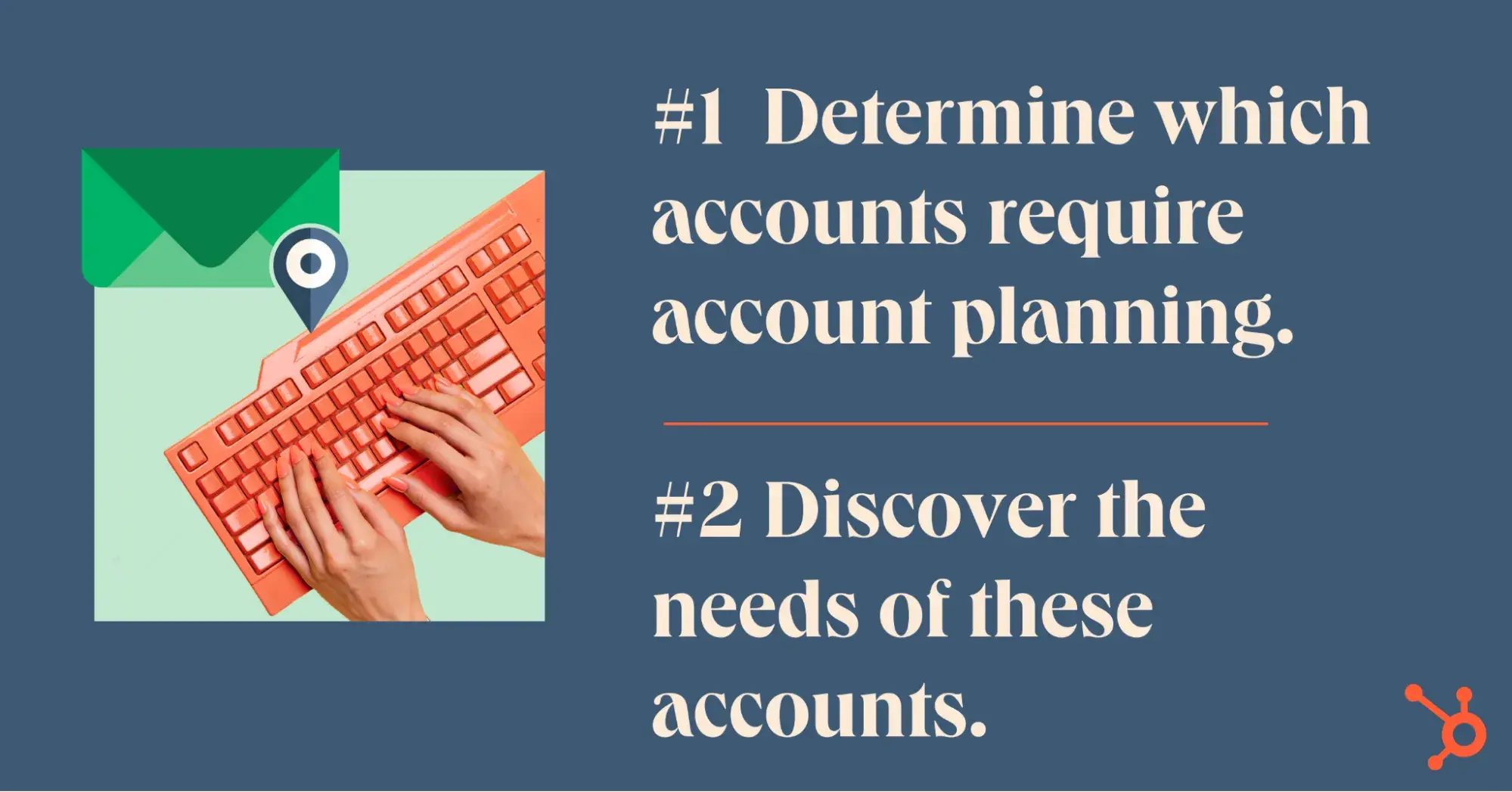
1. Determine which accounts require account planning.
Not all prospects need an account plan. Since it is a time-intensive process, creating one for a prospect who does not deliver ROI on your time, energy, and capital isn’t what I would recommend.
A sales account plan requires various inputs to change account planning into strategic account planning. In other words, a strategic account plan brings the best results for larger organizations that bring higher ROI.
For this, sales teams use certain criteria to determine which organizations tick mark all these boxes. Along with this, I also consider asking a few questions to discover where organizations fit:
- Does the company offer various products or services or stick to a single department?
- What does their current customer base look like? How much has it grown over the years?
- Would partnering with them improve your reputation?
2. Discover the needs of these accounts.
There’s no success in account planning without knowing their needs. Once you’ve identified the accounts, it’s time to leverage customer intelligence data to find their needs, goals, pain points, and potential opportunities.
Identifying the needs requires deep research into current market trends, market share, buying behaviors, and more.
Use the following questions to jump better into the research:
- What are the goals of this client?
- What do they value the most?
- Who is involved in the buying decision process?
- What are their current plans to achieve goals?
- What KPIs do they measure?

3. Create actionable steps.
After doing your research, it’s time to develop actionable steps.
Though the sales account serves a common goal, it differs in terms of structure and implementation depending on the size and other factors.
Here’s what my sales plan includes:
- Account analysis.
- Short-term steps (e.g., getting them to renew with you).
- Long-term steps (e.g., long-term client growth).
4. Execute the account plan.
Lastly, execute the plan using the information you’ve gathered so far. You can also use your information in the initial stages to build recognition.
It’s good to start a conversation that engages your prospects and tempts them to answer.
Some of the questions I use include:
- Hey, Company A. I noticed that you launched product X. How is this different from a similar product by company B? How do you see your business evolving in the next 6-12 months with this?
- Based on our research, we think that you’re missing out on ‘X’ goal. Can we help you achieve this goal and measure it going forward?
- How do you measure success within your team/department/company?
Sales Account Planning Process
- Use an account planning template.
- Summarize your customer’s business strategy.
- Know your customer’s key business initiatives.
- Understand your customer’s organizational chart and key players.
- Audit your customer’s products and revenue.
- Analyze your customer’s competition.
- Outline the buying process and selling points for prospective contacts.
- Establish a strategy for growing your relationship with your customer.
- Identify sales opportunities, targets, and risks.
- Create an action plan.
- Review your plan with your customer.
Section 1: Business Overview
The most effective account managers and sales teams understand their customer’s narratives. They ask value-focused questions to get to the root of their customer’s business objectives, internal and external challenges, and industry landscape.
This questioning and learning must be an ongoing exercise. Objectives and goals are ever-changing, and customers often reposition their value in the face of new technology or market shifts.
In this section, I’ll need you to identify the following:
- Your customer’s vision/strategy.
- Your customer’s vital numbers.
- The year the company was founded.
- Your customer's annual revenue.
- Number of employees who work for your customer.
- Popular target markets in the customer's industry.
After creating an account plan and getting to know your customer inside out, here are a few questions your account managers can ask:
- “We noticed that your industry has seen a decline in _______. How has your business fared since this trend started?”
- “Your competitor recently developed a new product. How does leadership plan to tackle this new challenge?”
- “Your initiatives for ________ did well for Q4 of last year, resulting in X% growth in revenue. Do you have any plans to continue those initiatives in Q1? What challenges do you foresee?”
- “I saw that you expanded into the ________ market. How has that been going? Are there any plans to expand into related industries?”
Section 2: Key Business Initiatives
As former FBI hostage negotiator Chris Voss outlines in his book Never Split the Difference, all successful negotiations begin with listening.
To develop a value-based action plan, you need to discover what your customer values most.
So, I recommend focusing on your customers' value expectations to create opportunities to grow more strategic customer relationships.
Use questions that help uncover key information about your customers, including:
- Short-/medium-/long-term priorities.
- Key projects.
- Key performance indicators (KPIs).
Section 3: Customer Relationship Landscape
Your customer relationship landscape is essentially what you know about your audience based on the connections you’ve been making with your clients. Knowing what they appreciate, how they want to communicate, and even the aspects of your business they admire most will save time and help them reach new goals.
Which type of clients are you helping the most? Where do you find more growth potential and positive feedback? It’s time to ask these questions and turn them into the customer approach that your account plan will follow.
Section 4: Customer Products and Revenues
This is the section where you can boast of your product offerings. In this section, list and describe where you are currently adding value, analyze the ROI of that value, and identify gaps in the value chain.
For instance, a SaaS business might highlight its value proposition USPs with features that its competitors lack.
Here’s what can be included in the section:
- Whitespace analysis.
- Current sales performance.
- Current margin performance.
- Wins or losses over the last 12 months.
Section 5: Competitor Analysis
Competitor analysis is one of the crucial stages of sales planning. Performing a competitive analysis for your customer may not provide high value to your sales team, but I encourage you to remember: Your goal is to move from a transactional relationship to a strategic partnership.
Here’s what I prefer adding in this section:
- Competitors in your market niche.
- Competitors’ strengths.
- Competitors’ weaknesses.
Section 6: Buying Process and Selling Points
Businesses don’t buy products or services — people do. So, expand your organizational chart from section three to include personal motivations and decision criteria, and plot your value-based selling points to specific members of your customer’s organization.
The goal of a trusted advisor should not be to fit a product into an empty slot. Rather, your focus should be on understanding how your key selling points match each decision-maker’s goal.
Identify each of the following:
- Evaluation criteria.
- Key decision criteria.
- Key selling points.
Section 7: Relationship Goals and Strategy
Before an account manager can move the customer relationship forward, they must establish the status of their current client relationship. Knowing where we’re starting helps us get the right resources to build solid foundations and effectively approach the next steps.
Next, use this organizational chart from section three and the motivations from section six to determine which relationship target has the greatest opportunity for engagement.
I suggest focusing on those who can provide the most productive outcomes for both the customers and your own business.
Expand your relationship landscape to include the following:
- Current relationship status (Vendor, Preferred Supplier, Planning Partner, Trusted Advisor).
- Core business partners.
- Relationship target (who, what, where, how, why).
- Relationship progression strategy.
Section 8: Sales Opportunities, Targets, and Risks
Once you’ve documented your customers' objectives, motivations, and key relationships, determine the products/services that will help them attain their goals. List revenue goals and identify blockers, internal and external.
List and define:
- Two-year revenue goals.
- Customer needs for products/services.
- Cross-sell and upsell opportunities.
- Risks, barriers, and limitations.
- Operational restrictions.
It can be easy to gloss over the final bullet — operational restrictions. However, I think this exercise can illuminate friction in service/product delivery and reveal opportunities for automation and processes that can impact your entire book of business.
Section 9: Action Plan
Although there may be many value-added opportunities, narrow your focus to a small subset.
Start by determining which team members will own which tasks and what resources will be required to achieve them, and agree upon accountability measures.
Here’s a prerequisite that I suggest in every action plan:
- Identify the top five objectives.
- Create a list of critical resources.
- Assign tasks and key owners.
Section 10: Plan Review
Discuss value co-creation with your customer. Ensure you have correctly defined and prioritized value opportunities and work with them to provide relevant materials or resources to secure buy-in.
Engage the customer in a collaborative role to establish a process, timeline, and next steps.
I’ve collected some of the best strategic account planning templates you can use right now.
10 Strategic Account Planning Templates
1. HubSpot’s Account Planning Template [Google Docs]
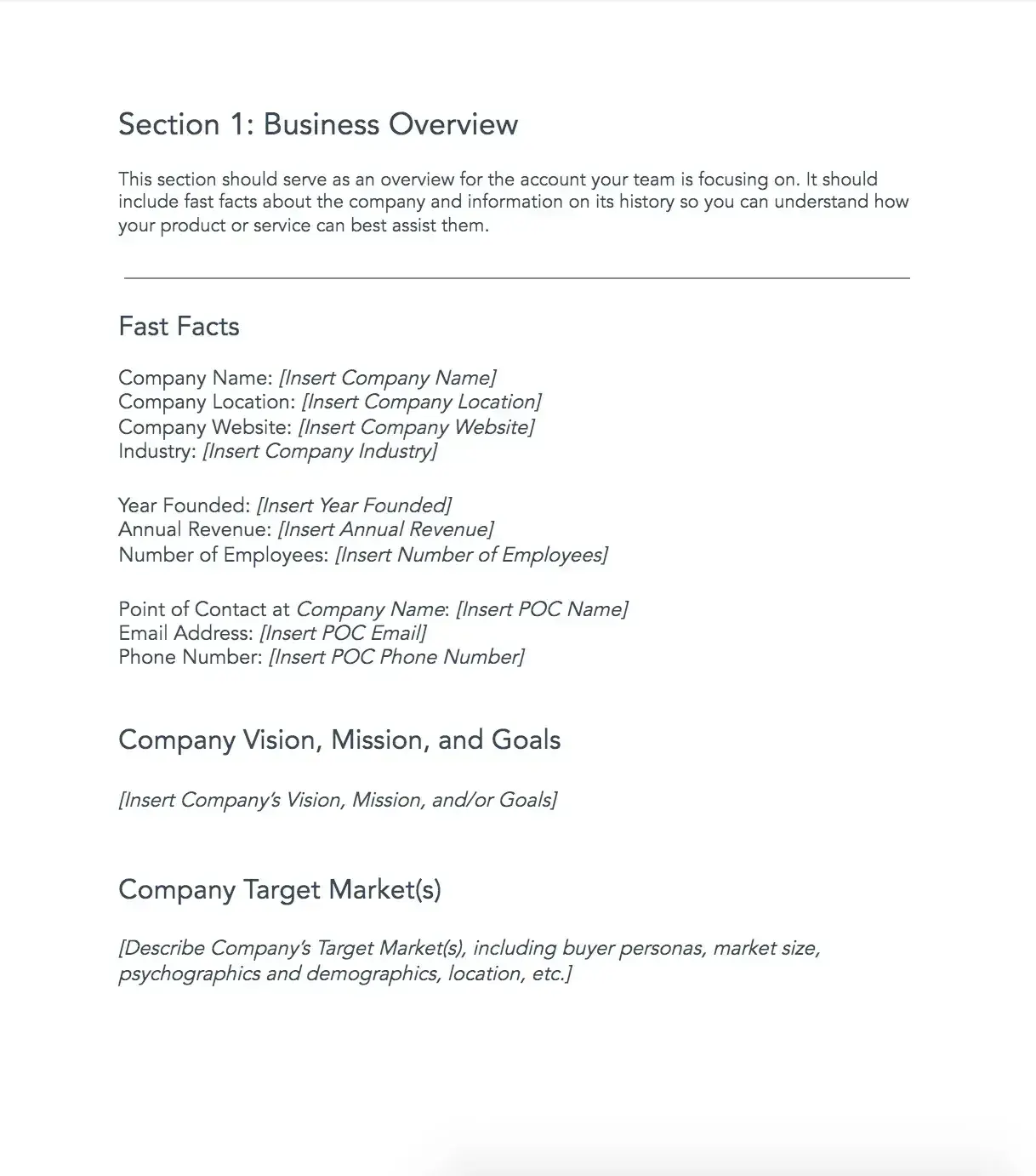
I think you’re familiar with HubSpot’s account planning template by now! It’s useful for account managers who want the freedom to personalize their account plan with a strong marketing basis.
I like that this template includes all the items discussed before, making it a comprehensive resource for startups and big businesses. It can help small and large teams by providing an actionable step-by-step guide for account managers, sales executives, and marketing professionals to collaborate within the account planning process.
2. Databahn Account Plan Template [XLS]
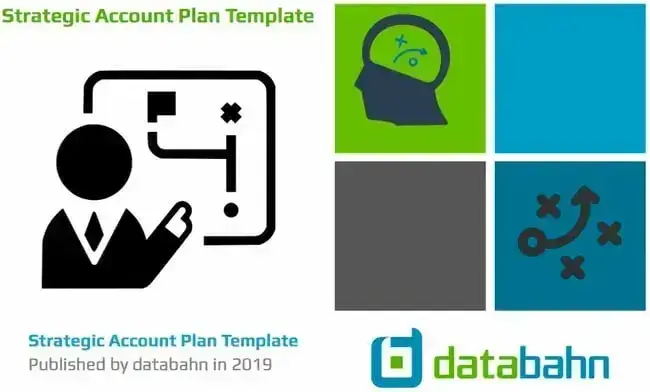
Databahn offers a free strategic account plan template that’s a good option for account management teams trying to streamline their account planning processes. What I like about this template is it's easy to use and easily customizable.
It also includes different details like the members of the team, sales strategies and targets, industry analysis, and annual reports.
Pro tip: Even when completed, the account planning template needs to be constantly updated to be as effective as possible.
3. Gartner’s Key Account Plan Template
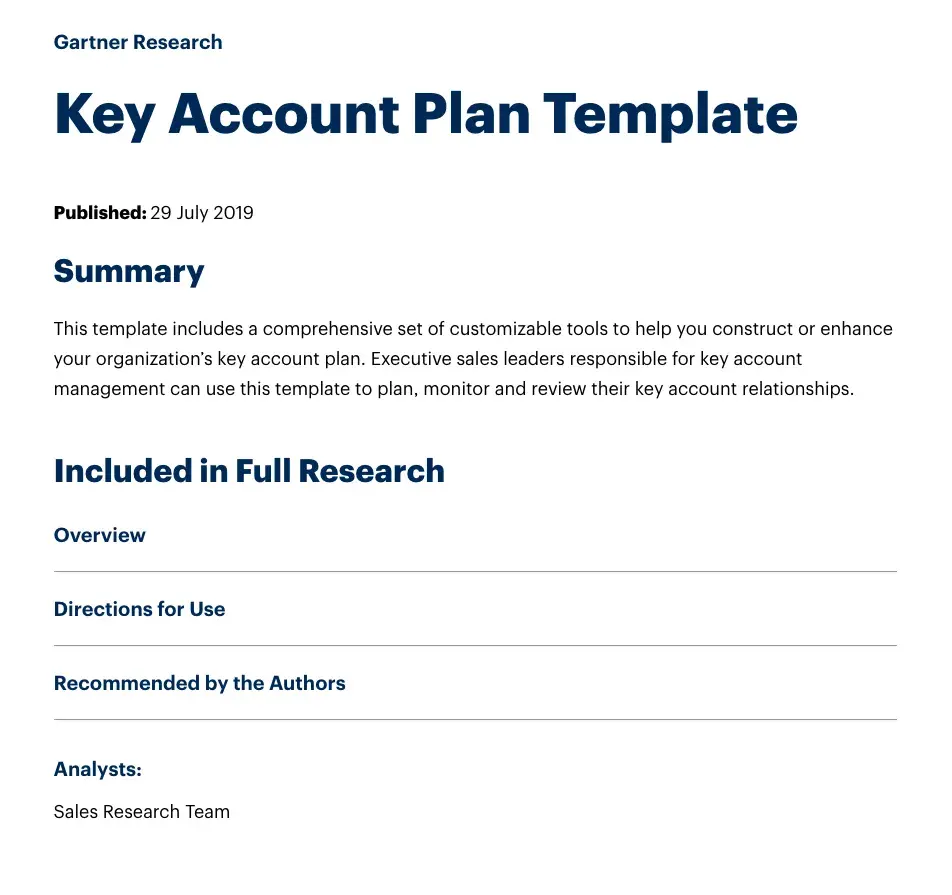
[alt[ Gartner key account template
Gartner, the leading information technology research and advisory company, offers a template that includes a comprehensive set of customizable tools to help executive sales leaders construct or enhance their organization’s critical account plan.
This template works best for executive sales leaders when planning, monitoring, and reviewing their key account relationships.
4. Confluence’s Sales Account Planning Template
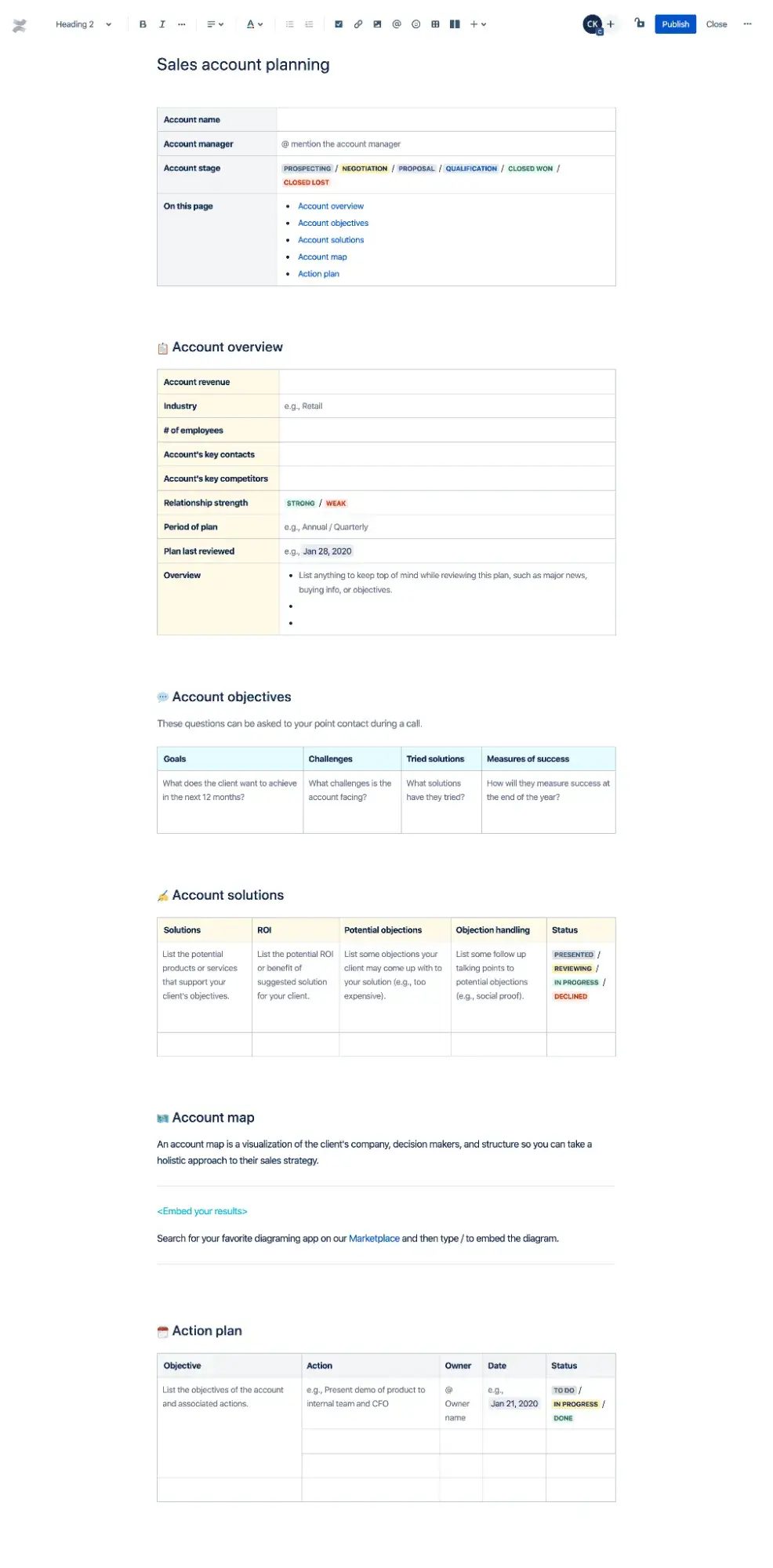
Confluence offers a sales account template that can help sales teams map out account objectives, solutions, and overall plans. Accessing the template requires a (free) signup to Confluence with no credit card needed.
5. Intercom’s Account Plans [XML]
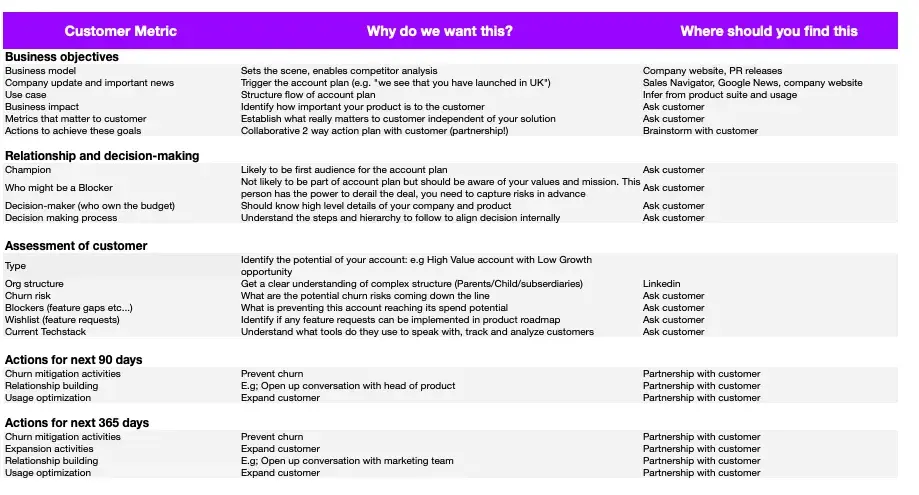
Intercom is a customer success company that works with tools that level up client relationships. This company offers an account plan template to help account managers maintain high customer satisfaction rates by using up-to-date information.
The spreadsheet format allows you to customize the elements within the template. I like that this template provides a 90-day action plan with details on organization structure, churn risk, their current tech stack, and expansion activities.
6. Unstrategic’s Strategic Account Plan [PDF]
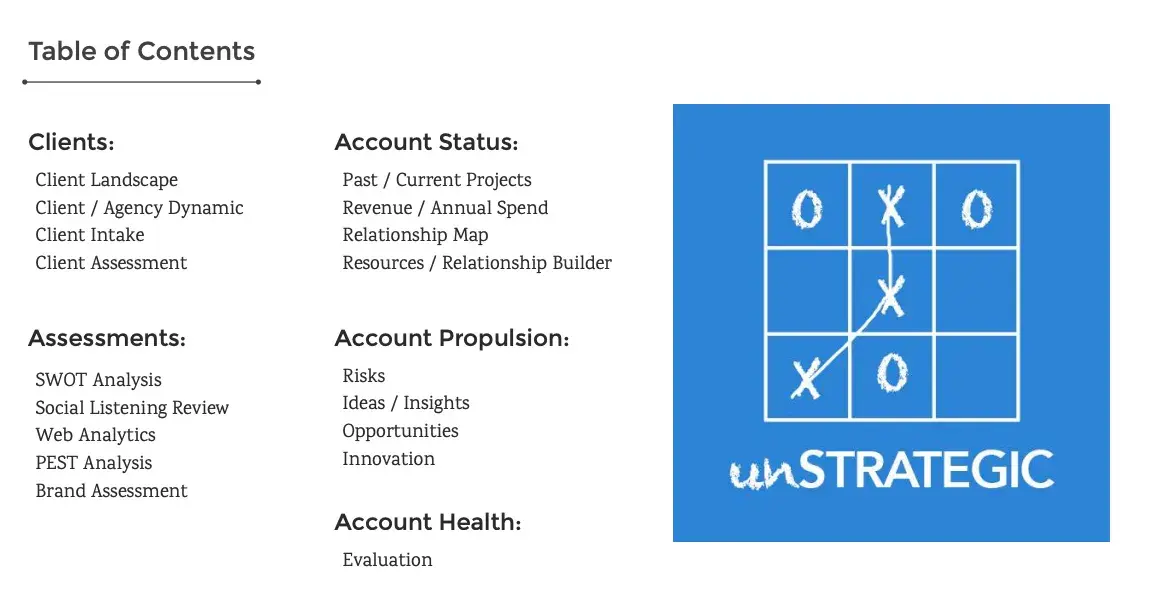
This easy-to-use template is an excellent resource for account managers and sales teams. It offers a detailed solution for companies to work on their account planning without struggling with technical misunderstandings.
This PDF guide offers a user-friendly content display and provides systematic instructions on how to fill out each section. I think it’s great for anyone filling out an account plan for the first time.
7. Revegy’s Account Planning Template
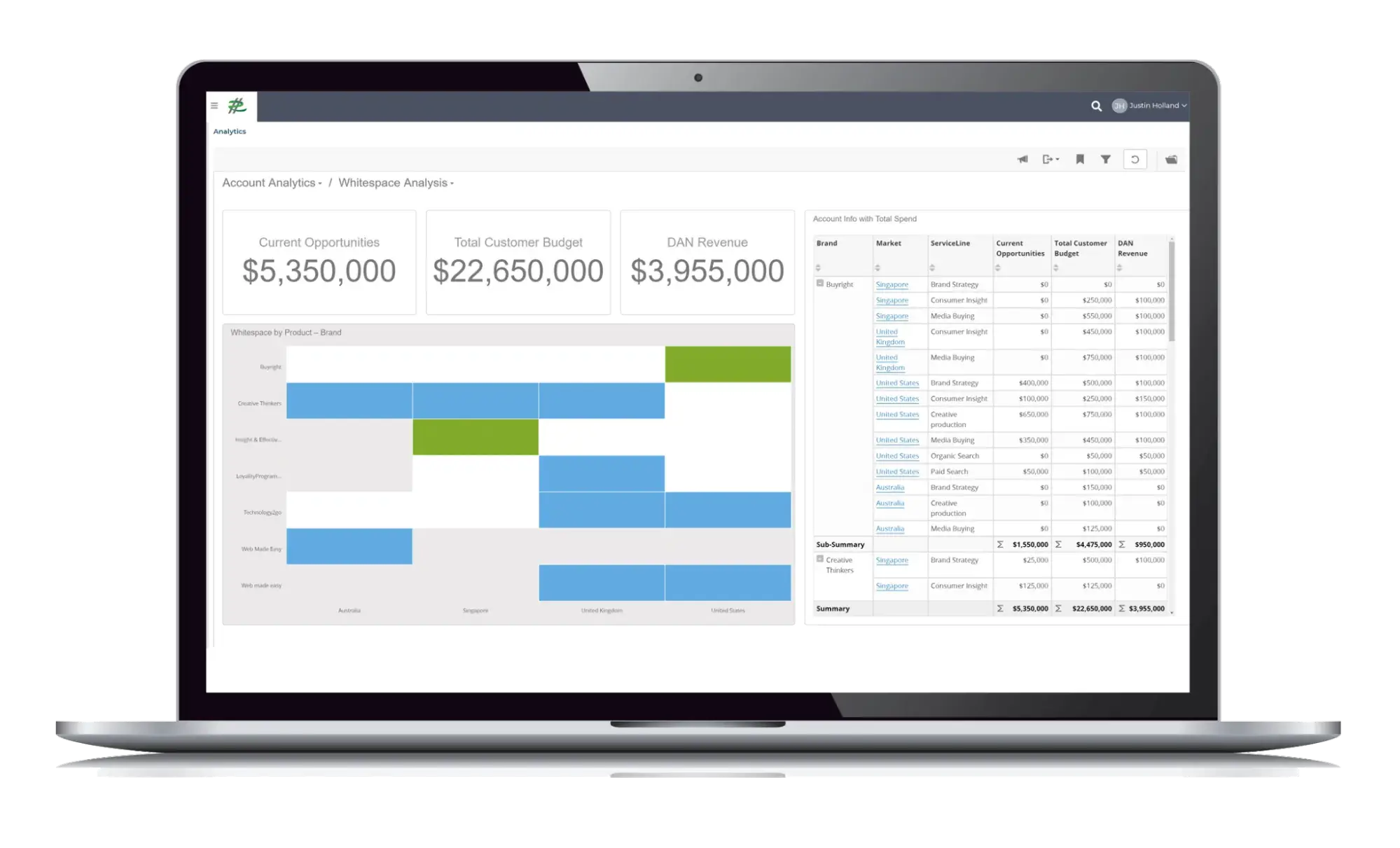
This guide is the best option for sales professionals who want to create effective sales strategies based on customer data.
This tool can help you build consistent account plans that are easy to understand and implement.
8. Avention’s Strategic Account Plan Template [PPT]
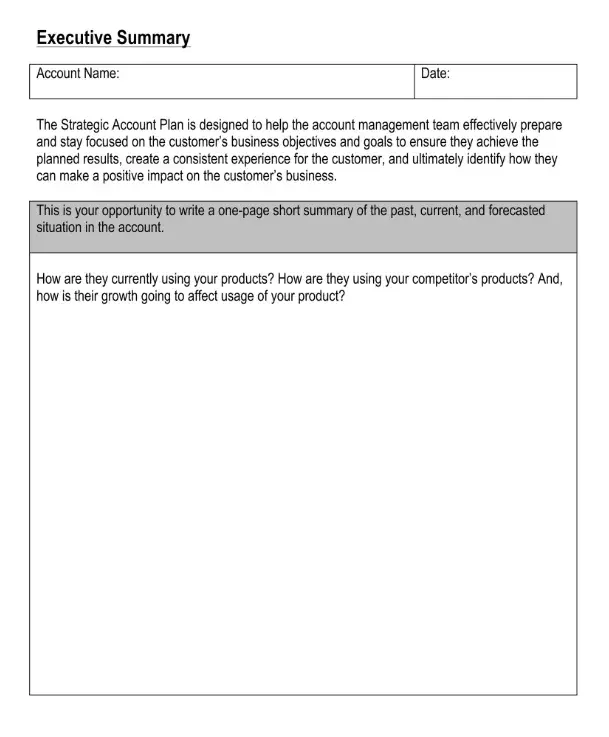
Avention made this template to assist the account management team in staying on top of the client’s business objectives and goals. It’s also helping them achieve desired results that will ultimately have a good impact on the customer’s business.
This detailed template allows me to explore various aspects of the accounts, such as current trends, product offerings, organizational charts, and more.
9. Get2Growth Strategic Account Planning Template [PPT]
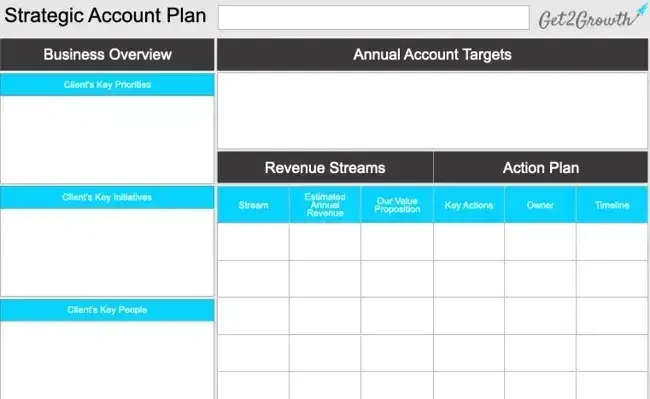
Get2Growth offers a one-page detailed template with four sections. This template can be used to build an account plan in a few steps.
These sections are:
- Business overview that covers client’s requirements and priority.
- Annual account targets.
- Revenue streams covering estimated annual revenue and value streams.
- Action plans.
With different graphic elements and sections, this template is a good solution for account professionals who want to achieve an innovative account managing approach based on quick solutions.
10. Ultimate One Page Key Account Plan & Template by the KAM Coach
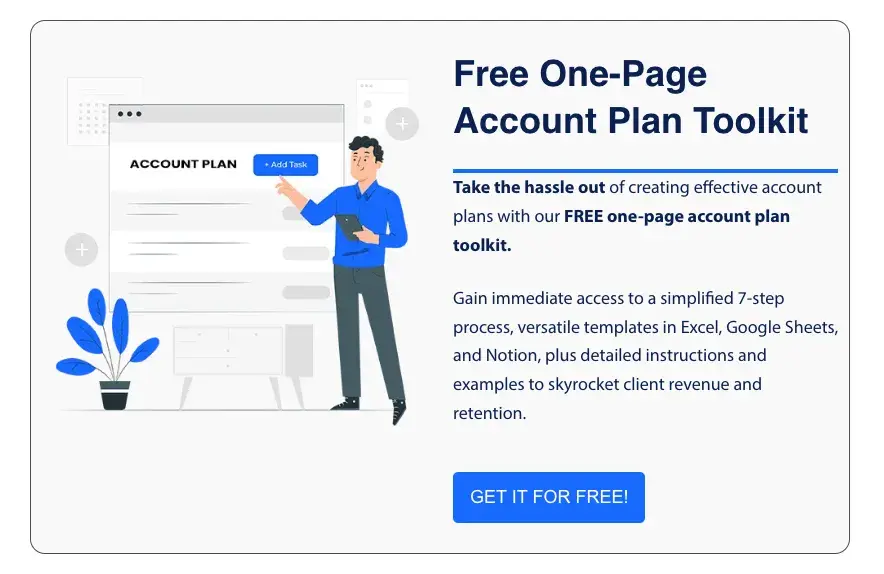
This one-page template offers a streamlined approach to key account management. I think that by using just a single page, the plan helps teams eliminate redundancy and focus on what’s most important to clients.
Supporting Account Planning with Account-Based Marketing Software
For a more effective account plan, I recommend using the HubSpot sales plan template with account-based marketing (ABM). That’s how our next planning process unfolds. But there’s no need to do it manually! Instead, I’d recommend using ABM software that can help you automate your ABM campaigns.
Several different account-based marketing software platforms — including HubSpot ABM Software, Terminus, and Demandbase — can support your efforts.
High-quality ABM software generally features tools and resources to help you establish a solid foundation for an account planning strategy. I find it’s typically rooted in defining and understanding your ideal customer profiles (ICPs).
Other tools — like workflow for building and maintaining ICPs — can also be very helpful for successful account planning.
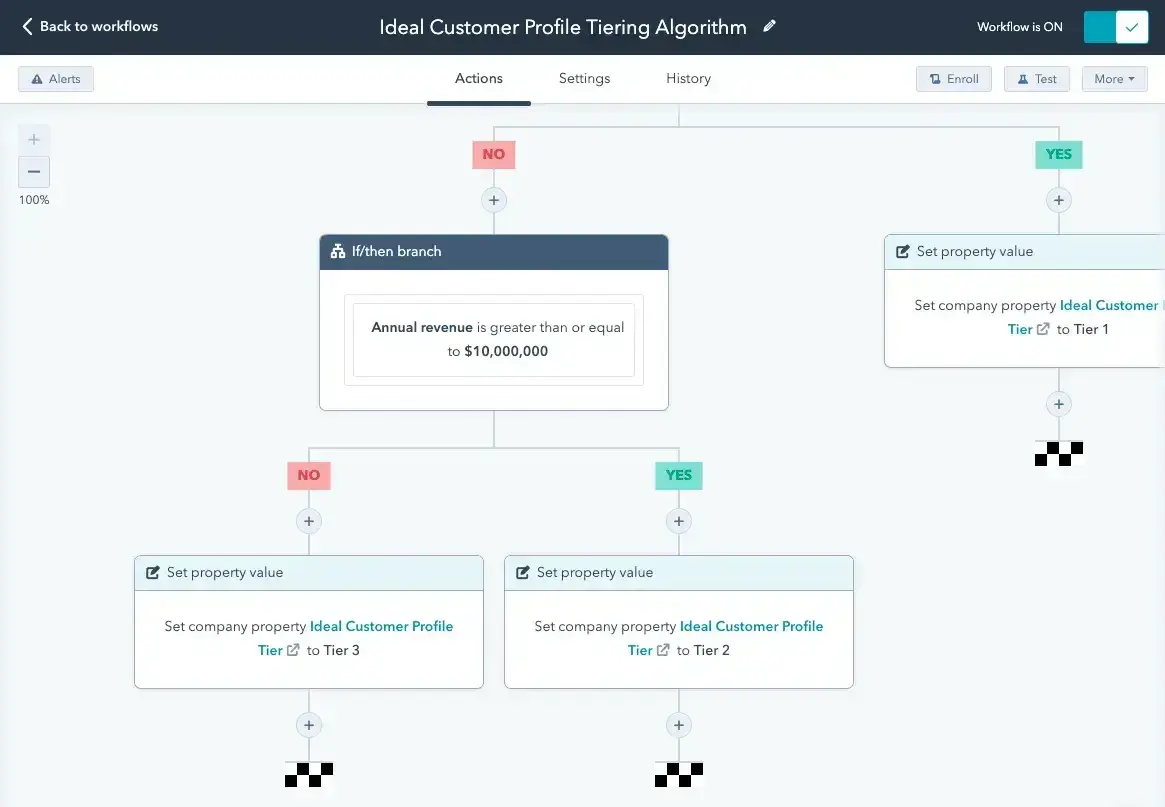
Here’s how a workflow looks in HubSpot’s ABM software. Specific actions are triggered depending on previous settings, automatically segmenting your ICPs by tier.
Personalization and Engagement
The fundamental basis of ABM is personalization. It's a process rooted in understanding and approaching individual accounts on terms that will specifically resonate with the prospects and customers behind them.
Sales plans have features designed to compile lists of target companies with similar characteristics. These features can help you group like-minded companies and contacts for streamlined outreach.
Some types of ABM software allow you to send ads to influencers within your targeted accounts across certain platforms — typically LinkedIn.
One way or another, it's always in your best interest to reach your target accounts in ways that suit their unique values and characteristics.
Tracking and Measuring Efforts
Account planning isn‘t a static process. You need to constantly look for ways to modify your strategy as you interact with more customers. That’s why we need resources to track the efficacy of your efforts.
Target account reporting libraries can help you monitor target accounts.
HubSpot’s ABM software includes resources for reviewing internal stakeholders within your target companies. This allows you to see who's supporting, blocking, or influencing your efforts.
It also helps to have visibility into the different interactions your business has with a target company. Some types of ABM software allow you to monitor activity like emails, meetings, and logged calls. Tools like that will enable you to understand where and how to improve your outreach and planning.
How can an ABM support your account plan?
Regardless of which you choose, ABM software will save your sales team time and give you the tools to manage your key customer relationships.
You now have all the resources you need to build a successful account plan from scratch, starting with the main questions and all the implementation steps that will help you get there. Are you ready to turn account planning into a valuable asset for your business?
Getting Started With Strategic Account Planning
Account planning is crucial for building stronger, more strategic relationships with clients in a B2B setting. Instead of a cold calling with no knowledge of the prospect, it gives me valuable information covering their pain points, audiences, and long and short-term goals.
Perhaps the most important piece of advice I can offer is to start implementing account planning as soon as possible, even if it’s on a small scale. Start with account plans and dig deeper with ABM tool to build better client relationships and drive sustainable business growth.
Editor's note: This post was originally published July 2019 and has been updated for comprehensiveness.
Revenue Operations
.png?width=112&height=112&name=Image%20Hackathon%20%E2%80%93%20Vertical%20(34).png)

.png?width=320&height=415&name=Image%20Hackathon%20%E2%80%93%20Vertical%20(34).png)
.png)

.jpg)
.jpg)

![Account Management vs. Sales: What's the Difference? [FAQ]](https://53.fs1.hubspotusercontent-na1.net/hubfs/53/136_Account%20Management%20vs.jpg)